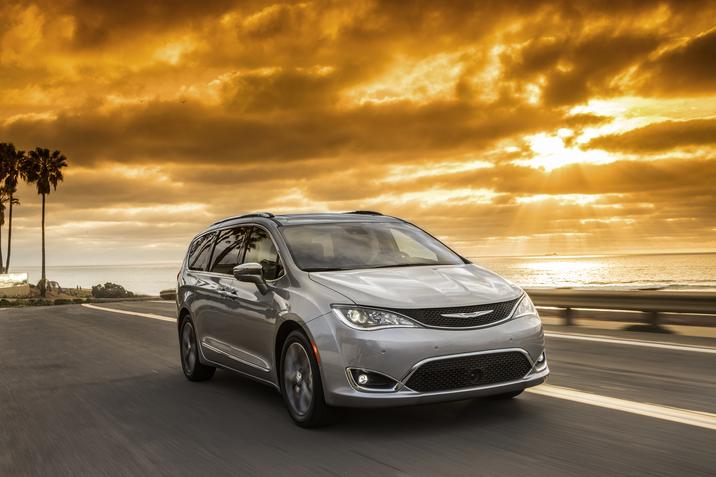Pacifica’s new materials enable use of less steel, resulting in weight reduction, while still offering greater stiffness and safety.
September 18, 2017

Using a blend of advanced materials, Fiat Chrysler engineers have created a stiff minivan body that’s 168 lbs lighter than predecessors.
The new Chrysler Pacifica uses ultra-high-strength steel in its body and load beams, aluminum in its hood and sliding doors, and magnesium in its liftgate, helping cut weight and enhance its claim of best-in-class fuel efficiency. “We got a lot of weight out of the body structure while improving the NVH (noise, vibration and harshness) and the safety performance,” James Truskin, Technical Fellow for Fiat Chrysler’s Body-In-White group, told Design News. “We needed to be diligent about the optimization of every component, making sure we had the right material in the right place.”
|
Using ultra high-strength steel, Fiat Chrysler engineers cut the weight of the Pacifica’s body-in-white by about 12%. (Source: Fiat Chrysler Automobiles N.V.) |
The key to the automaker’s lightweighting effort was its use of ultra high-strength steel. Ultra high-strength steel, typically defined as having a yield strength of greater than 780 MPa (about 113 ksi), enabled Fiat Chrysler engineers cut the weight of the so-called body-in-white (the car body prior to the addition of hoods, doors, decklids and fenders) by about 12%. The team accomplished that by employing tailor-welded, hot-stamped steel around the doors to create big, ultra high-strength blanks.
“We used tailor-welded blanks on the previous car, but by doing this one as hot stamped, we were able to get additional strength,” Truskin said. The technology to accomplish that was not available previously, he added.
At the same time, the company’s engineers used aluminum in the vehicle’s hood, doors and rear-end liftgate. The use of aluminum in the minivan’s doors and liftgate represented a change for the automaker, which used mild steels in the past.
Engineers also employed cast magnesium components for the Pacifica’s internal structural elements in the doors. The use of magnesium minimized mass, Truskin said, while enabling engineers to combine multiple components into a single casting, thereby reducing assembly costs.
“When we compared all the possible options, the combination of magnesium inner and aluminum outer gave us good weight savings and a competitive business case, as well,” Truskin told us.
By employing advanced materials on the Pacifica, Fiat Chrysler joins a growing number of automakers who are migrating to advanced high strengths steels and aluminum on new vehicle lines. Ford Motor Co., for example, used a high-strength, dual-phase steel for about 78% of the frame on its new F-150 pickup, up from about 23% on earlier models. Ford also employed aluminum alloys in the F-150’s cab, hood, tailgate, floor, fender, doors, front end, pickup box and numerous other parts. Similarly, Chevrolet used 60% high-strength steel in the frame of its Colorado pickup, and Fiat Chrysler featured 60% high-strength steel in the frame of its Chrysler 200.
The use of advanced steels with higher yield strengths provides numerous advantages, engineers say. The Pacifica, for example, uses ultra high-strength steel with a yield strength approaching 116 ksi (800 MPa). By comparison, conventional mild steels offer a yield strength of about 26-40 ksi (180-280 MPa). Because advanced high-strength and ultra high-strength steels offer so much more load-carrying capacity, engineers are able to use less steel, resulting in weight reduction, while still offering greater stiffness and safety.
Advanced steels typically also offer a higher modulus of elasticity, which translates to better resistance to forces that might otherwise leave dents in the vehicle’s body.
One key to making more use of the new materials is the availability of better CAE (computer-aided engineering) tools, which enable engineers to more accurately predict their behavior, Truskin said. “A lot of the work done by ourselves and others has helped put us in a position to have higher confidence in the use of aluminum in places where it wasn’t used before,” he told us.
Automakers say the new materials help them meet increasingly tougher standards, especially in terms of corporate fuel economy. On average, manufacturers get a 0.5% bump in fuel economy for each 1% in weight reduction, experts say.
|
The plug-in hybrid version of the Pacifica earned a US EPA fuel economy ratings of 84 MPGe (miles per gallon equivalent), making it the most efficient minivan ever. (Source: Fiat Chrysler Automobiles N.V.) |
That’s why improvements like those in the Pacifica matter, Truskin said. The conventionally powered Pacifica recently earned a highway fuel economy rating of 28 mpg from the US EPA, while the plug-in hybrid version came in at 84 MPGe (miles per gallon equivalent), making it the most efficient minivan ever.
“On the Pacifica, we used a new process and a new strategy,” Truskin said. “And we’re going to continue using that on all of our architectures moving forward.”
Senior technical editor Chuck Murray has been writing about technology for 33 years. He joined Design News in 1987, and has covered electronics, automation, fluid power, and auto.
|
About the Author(s)
You May Also Like






